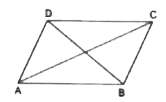Complete Solutions to EXERCISE A of chapter QUADRILATERALS of Class 6 book with complete answers and questions
| Class 6 | MATHS |
| Chapter | QUADRILATERALS |
| RS AGGARWAL | EXERCISE A |
| Number Of Questions | 8 |
| Academic Year | 2023-24 |
In the adjacent figure, a quadrilateral has been shown.
(i) its diagonals.
(ii) two pairs of opposite sides.
(iii) two pairs of opposite angles.
(iv) two pairs of adjacent sides.
(v) two pairs of adjacent angles.

View SolutionDraw a parallelogram ABCD in which AB = 6.5 cm, AD = 4.8 cm and `angleBAD=70^(@)`. Measure its diagonals.
View SolutionTwo sides of a parallelogram are in the ratio `4 : 3`. If its perimeter is `56 cm`, find the length and breadth .
View SolutionName each of the following parallelograms:
(i) The diagonals are equal and the adjacent sides are unequal.
(ii) The diagonals are equal and the adjacent sides are equal.
(iii) The diagonals are unequal and the adjacent sides are equal.
View SolutionWhat is a trapezium? When do you cell a trapezium an isosceles trapezium? Draw an isosceles trapezium. Measure its sides and angles.
View SolutionWhich of the following statements are true and which are false?
(a) The diagonals of a parallelogram are equal.
(b) The diagonals of a rectangle are perpendicular to each other.
( c) The diagonals of a rhombus are equal.
View SolutionGive reasons for the following:
(a) A square can be thought of as a special rectangle.
(b) A square can be thought of as a special rhombus.
( c) A rectangle can be thought of as a special parallelogram.
(d) A square is also a parallelogram.
View SolutionA figure is said to be regular if its sides are equal in length and angles are equal in measure. What do you mean by a regular quadrilateral?
View Solution
EXERCISE A questions and complete solutions for chapter QUADRILATERALS of RS AGGARWAL MATHS (HINGLISH) of Class 6